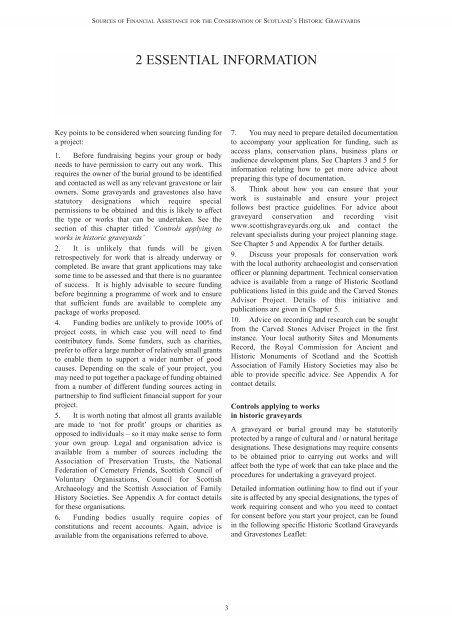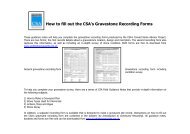get download - Carved Stones Advisor Project
get download - Carved Stones Advisor Project
get download - Carved Stones Advisor Project
Create successful ePaper yourself
Turn your PDF publications into a flip-book with our unique Google optimized e-Paper software.
SOURCES OF FINANCIAL ASSISTANCE FOR THE CONSERVATION OF SCOTLAND’S HISTORIC GRAVEYARDS<br />
2 ESSENTIAL INFORMATION<br />
Key points to be considered when sourcing funding for<br />
a project:<br />
1. Before fundraising begins your group or body<br />
needs to have permission to carry out any work. This<br />
requires the owner of the burial ground to be identified<br />
and contacted as well as any relevant gravestone or lair<br />
owners. Some graveyards and gravestones also have<br />
statutory designations which require special<br />
permissions to be obtained and this is likely to affect<br />
the type or works that can be undertaken. See the<br />
section of this chapter titled ‘Controls applying to<br />
works in historic graveyards’<br />
2. It is unlikely that funds will be given<br />
retrospectively for work that is already underway or<br />
completed. Be aware that grant applications may take<br />
some time to be assessed and that there is no guarantee<br />
of success. It is highly advisable to secure funding<br />
before beginning a programme of work and to ensure<br />
that sufficient funds are available to complete any<br />
package of works proposed.<br />
4. Funding bodies are unlikely to provide 100% of<br />
project costs, in which case you will need to find<br />
contributory funds. Some funders, such as charities,<br />
prefer to offer a large number of relatively small grants<br />
to enable them to support a wider number of good<br />
causes. Depending on the scale of your project, you<br />
may need to put to<strong>get</strong>her a package of funding obtained<br />
from a number of different funding sources acting in<br />
partnership to find sufficient financial support for your<br />
project.<br />
5. It is worth noting that almost all grants available<br />
are made to ‘not for profit’ groups or charities as<br />
opposed to individuals – so it may make sense to form<br />
your own group. Legal and organisation advice is<br />
available from a number of sources including the<br />
Association of Preservation Trusts, the National<br />
Federation of Cemetery Friends, Scottish Council of<br />
Voluntary Organisations, Council for Scottish<br />
Archaeology and the Scottish Association of Family<br />
History Societies. See Appendix A for contact details<br />
for these organisations.<br />
6. Funding bodies usually require copies of<br />
constitutions and recent accounts. Again, advice is<br />
available from the organisations referred to above.<br />
7. You may need to prepare detailed documentation<br />
to accompany your application for funding, such as<br />
access plans, conservation plans, business plans or<br />
audience development plans. See Chapters 3 and 5 for<br />
information relating how to <strong>get</strong> more advice about<br />
preparing this type of documentation.<br />
8. Think about how you can ensure that your<br />
work is sustainable and ensure your project<br />
follows best practice guidelines. For advice about<br />
graveyard conservation and recording visit<br />
www.scottishgraveyards.org.uk and contact the<br />
relevant specialists during your project planning stage.<br />
See Chapter 5 and Appendix A for further details.<br />
9. Discuss your proposals for conservation work<br />
with the local authority archaeologist and conservation<br />
officer or planning department. Technical conservation<br />
advice is available from a range of Historic Scotland<br />
publications listed in this guide and the <strong>Carved</strong> <strong>Stones</strong><br />
<strong>Advisor</strong> <strong>Project</strong>. Details of this initiative and<br />
publications are given in Chapter 5.<br />
10. Advice on recording and research can be sought<br />
from the <strong>Carved</strong> <strong>Stones</strong> Adviser <strong>Project</strong> in the first<br />
instance. Your local authority Sites and Monuments<br />
Record, the Royal Commission for Ancient and<br />
Historic Monuments of Scotland and the Scottish<br />
Association of Family History Societies may also be<br />
able to provide specific advice. See Appendix A for<br />
contact details.<br />
Controls applying to works<br />
in historic graveyards<br />
A graveyard or burial ground may be statutorily<br />
protected by a range of cultural and / or natural heritage<br />
designations. These designations may require consents<br />
to be obtained prior to carrying out works and will<br />
affect both the type of work that can take place and the<br />
procedures for undertaking a graveyard project.<br />
Detailed information outlining how to find out if your<br />
site is affected by any special designations, the types of<br />
work requiring consent and who you need to contact<br />
for consent before you start your project, can be found<br />
in the following specific Historic Scotland Graveyards<br />
and Gravestones Leaflet:<br />
3




